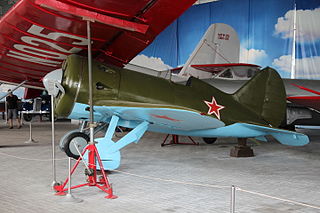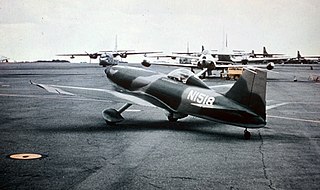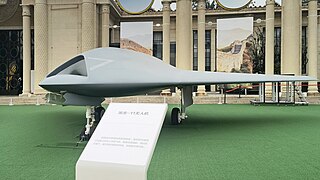
The Polikarpov I-16 is a Soviet single-engine single-seat fighter aircraft of revolutionary design; it was the world's first low-wing cantilever monoplane fighter with retractable landing gear to attain operational status and as such "introduced a new vogue in fighter design". The I-16 was introduced in the mid-1930s and formed the backbone of the Soviet Air Force at the beginning of World War II. The diminutive fighter, nicknamed "Ishak" or "Ishachok" by Soviet pilots, figured prominently in the Second Sino-Japanese War, the Battle of Khalkhin Gol, Winter War and the Spanish Civil War – where it was called the Rata ("rat") by the Nationalists or Mosca ("fly") by the Republicans. The Finns called the aircraft Siipiorava "(flying squirrel)".
The Yokosuka MXY9 Shuka was a projected development of the MXY8 training glider, adding a small motorjet engine, the Tsu-11. It was intended to provide further training for pilots who were to fly the Mitsubishi J8M and Ki-200 rocket-powered interceptor aircraft.

The Nakajima Kikka, initially designated Kōkoku Nigō Heiki, was Japan's first turbojet-powered aircraft. It was developed late in World War II, and the single completed prototype flew only once before the end of the conflict.

The Fuji T-1 was Japan's first jet-powered trainer aircraft. Its first flight was in January 1958. A total of 66 T-1 planes were built. It was retired in March 2006.

The Mizuno Shinryū/Jinryū was a late-World War II Japanese rocket-powered interceptor. While the Jinryū was still in development, Mizuno began to develop an interceptor which both the Army and Navy air force were in desperate need of to fend off the Boeing B-29 Superfortress. When Japan surrendered to the Allies on 15 August 1945, all aircraft that were under development were stopped, including the Jinryū & Shinryū II. The Shinryū II was the second aircraft developed in Japan to use a canard design, after the Kyushu J7W Shinden.

The Kawasaki Ki-60 was an experimental Japanese pre-World War II fighter aircraft that used a license-built (Kawasaki) DB 601 liquid-cooled engine. This was at that time an unusual choice because the majority of Japanese aircraft at that time used air-cooled radial engines.

The Nakajima A1N, or Navy Type 3 Carrier Fighter, was a Japanese carrier-based fighter of the late-1920s and early-1930s. It was a licensed copy of the British Gloster Gambet fighter, built by the Nakajima Aircraft Company for the Imperial Japanese Navy. Approximately 150 were built in two versions, the A1N1 and A1N2.

The Mitsubishi B1M was a Japanese torpedo bomber of the 1920s, also known as the Navy Type 13 Carrier-Borne Attack Aircraft. It was designed and built by Mitsubishi and used in combat against China. The aircraft was used by the air services of the Imperial Japanese Navy and Imperial Japanese Army.

The Kawasaki C-2 is a mid-size, twin-turbofan engine, long range, high speed military transport aircraft developed and manufactured by Kawasaki Aerospace Company. In June 2016, the C-2 formally entered service with the Japan Air Self-Defense Force (JASDF). There are ongoing efforts to sell it overseas to countries such as New Zealand and the United Arab Emirates.

The Soko J-21 Jastreb, referred to as the J-1 Jastreb in some sources, is a Yugoslav single-seat, single-engine, light attack aircraft, designed by the Aeronautical Technical Institute (ATI) and Vojnotehnički Institut Beograd (VTI), in Belgrade and manufactured by SOKO in Mostar. Derived from the G-2 Galeb advanced jet trainer and light attack aircraft, it was designed in single-seat ground-attack and two-seat advanced flying / weapon training versions.
The Xian H-8 bomber was a Chinese military aircraft and a possible successor to the aging twin-engined Xian H-6 jet bomber. It is referred to as Xian H-7 in some sources. The proposed designs were reported to be an enlarged H-6 with four or six underwing engines, but the project was canceled in 1971 in early development stage.

The Nakajima Ki-11 was an unsuccessful attempt by Nakajima Aircraft Company to meet a 1935 requirement issued by the Japanese government for a modern single-seat monoplane fighter suitable to meet the needs of both the Imperial Japanese Army Air Force and Imperial Japanese Navy Air Service

The Japanese Air Force One and Japanese Air Force Two are the radio callsigns of the two Boeing 777-300ER aircraft used by the government of Japan for overseas travel by the Emperor, Prime Minister and other high-ranking officials. Each aircraft has a capacity of 140 passengers and can be used for emergency evacuations of Japanese citizens and overseas deployment of Japan Self-Defense Forces personnel. The aircraft are operated by the Japan Air Self-Defense Force.
The Chu XP-0, also known as the Chu (AFAMF) XP-0, was a Chinese fighter prototype in the Second World War.

The Junkers K 47 was a two-seater fighter aircraft developed in Sweden by the Swedish subsidiary of the German firm Junkers during the late 1920s, a civil development of which was designated the A 48.

The American Electric Piranha was a prototype American counter-insurgency aircraft. Designed by Milt Blair and Dick Ennis in the early 1960s, it was built by the American Electric Corporation.

The Shenyang JJ-1, also known as the Hong Zhuan-503 or Red Special, was a jet trainer developed in the People's Republic of China (PRC) during the 1950s. It was the first jet aircraft designed in China, with Xu Shunshou as the chief designer. Two prototypes flew, but further development was abandoned.

The Hongdu GJ-11 Sharp Sword is an unmanned combat aerial vehicle developed in the People's Republic of China for the People's Liberation Army. It was designed by Shenyang Aircraft Design Institute and Hongdu Aviation Industry Group (HAIG), with the latter being the manufacturer. The GJ-11 may also perform aerial reconnaissance.

The Kawasaki C-5 was a 1930s Japanese civil high speed long range monoplane built for the Japanese Asahi Shimbun newspaper to gather and disseminate news across the Japanese empire.
DRUMS is an experimental spacecraft that will test proximity operation near space debris. The microsatellite carries two 'mock space debris' which once deployed will be used as a target for demonstrating approach and contact.

















